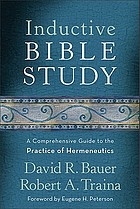26 items you could look for in your observation of the passage
Ask the six vital observation questions: What? Who? Where? When? Why? and How?Look for key words.
Look for repeated words and phrases.
Look for questions being asked.
Look for answers being given.
Look for commands.
Look for warnings.
Look for comparisons–things that are alike.
Look for contrasts–things that are different.
Look for illustrations.
Look for causes and effects and reasons for doing things.
Look for promises and their conditions for fulfillment.
Look for lists of things.
Look for results.
Look for advice, admonitions, and attitudes.
Look for the tone of the passage–emotional atmosphere.
Look for explanations.
Look for Old Testament quotes in the New Testament.
Look for the paradoxes.
Look for exaggeration.
Look for connectives (and, or, but, therefore etc.)
Look for the force of the verbs
Look for words and phrases to reveal feelings.
Look for anything unusual or unexpected.
Look at the grammatical construction of the sentences.
Look at the use of current events of the times.

